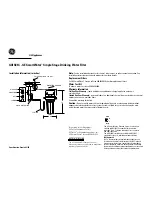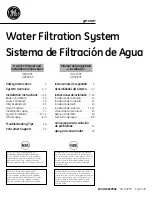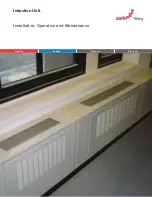
3
Design Requirements—Standard Applications
In standard applications, the Model A Royal Flush Concealed Automatic Sprin-
klers are intended for standard flow and pressure requirements as specified in
current NFPA 13 Standards.
Ceiling Cover Plates are available in a variety of metallic or painted finishes. For
custom painted finishes, the customer must furnish a quick-drying paint, prefer-
ably lacquer-based, to insure proper color duplication. One quart of paint is
required for each 200 cover plates.
Sprinklers must be handled care-
fully. They must not be transported
or stored where ambient temperature
may exceed 100
°
F/38
°
C. For best
results, store them in a dry, cool
location in the original shipping
package.
Do not install sprinklers that have
been dropped or visibly damaged.
Sprinklers should never be painted,
coated, plated or altered in any other
way from manufactured condition or
they may not function properly. Any
sprinklers altered in such manner
must be replaced.
The owner is responsible for the
proper operating condition of all fire
protection devices and accessories.
The NFPA standard 25 entitled,
“Inspection, Testing and Maintenance
of Water-Based Fire Protection
System”, contains guidelines and
minimum maintenance requirements.
Furthermore, the local Authori
ty
Having Jurisdiction may have addi-
tional regulations and requirements
for maintenance, testing, and inspec-
tion that must be obeyed.
It is advisable to have sprinkler
systems inspected regularly by a
qualified inspection service. Length
of time between such inspections can
vary due to accessibility, ambient
atmosphere, water supply, and site
activity.
Do not attempt to reassemble or
otherwise reuse a sprinkler that has
operated. Replace any sprinkler
exhibiting corrosion or damage;
always use new sprinklers of the
same orifice, style, and temperature
rating as replacements.
Because the discharge pattern is
critical to protection of life and
property, nothing should be hung or
attached to the sprinkler unit that
would disrupt the pattern. Such
obstructions must be removed. In the
event that construction has altered
the original configuration, additional
sprinklers should be installed to
maintain the protection level.
All Model A Royal Flush Concealed
Automatic Sprinklers must be in-
stalled according to current NFPA 13
Standards. Deviations from these
requirements and standards or any
alteration to the sprinkler itself will
void any warranty made by Central
Sprinkler Company. In addition,
installation must also meet local
government provisions, codes and
standards as applicable.
For standard applications the
system piping may be hydraulically
calculated. Check for the proper
model, style, orifice size, and tempera-
ture rating prior to installation. Install
sprinklers after the piping is in place to
avoid mechanical damage; replace
any damaged units. Wet pipe systems
must be protected from freezing.
Upon completion of the installation,
the system must be tested per
recognized standards.
In the event of a thread leak,
remove the unit, apply new pipe joint
compound or tape, and reinstall.
Installation Sequence
Step 1. The unit must be installed in
a pendent position.
Step 2. The face of the sprinkler
fitting should be installed a nominal
2" (
±
1
⁄
16
") (50.8 mm (
±
1.6 mm)) behind
the finished ceiling line.
Step 3. Use only a non-hardening
pipe joint compound or Teflon* tape.
Apply only to the male threads.
Step 4. Hand tighten the sprinkler
into the fitting. Use a Central Sprin-
kler Universal Sprinkler Wrench to
tighten the unit in the fitting. A leak
tight joint requires only 7 to 14 ft. lbs.
(9.5 to 19.0 Nm) of torque; a tangen-
tial force of 14 to 28 lbs. (62.3 to
124.5 N) delivered through a 6" (150
mm) handle will deliver adequate
torque. Torque levels over 21 ft. lbs.
(28.6 Nm) may distort the orifice seal,
resulting in leakage.
Step 5. To install the ceiling cover
plate, align it with and press it over
the support ring assembly, then push
upward and twist to the right.
Caution: Special care must be taken
when installing with a CPVC system.
Sprinklers must be installed only after
the primed and cemented pipe has
time to set-up to ensure that no
primer or cement accumulates within
the sprinkler.
Special care must be taken when
installing with a copper system.
Sprinklers must be installed only after
the inside of the sprinkler drop and
associated fittings have been wire
brushed to remove any flux. Residual
flux can cause corrosion and in
extreme cases can impair proper
sprinkler operation.
Design
Data
Installation
Care &
Maintenance
*Teflon is a trademark of the DuPont Corp.
OBSOLETE






















